Voices from the Ground
At 11:30 a.m. PT, millions across continents felt the internet shudder. Lives slowed, local routines frayed, and small voices amplified the wider impact:
- Riya Sharma, owner of a boutique café in Mumbai:
“Our POS went down—no orders, no receipts, no customers. We literally had to close for an hour.” - In Chennai, a remote telemedicine provider saw urgent appointments vanish mid-session: “A grandmother couldn’t get her insulin prescription this afternoon,” said Dr. Anil Kumar.
- High‑school student Sameer, in Delhi, watching a live class on Google Meet:
“My screen froze right during the exam prep. We panicked.”
Community centres and non‑profits felt it too:
Neighbourhood food banks relying on Google Cloud–hosted volunteer apps faced reservations cancelling mid‑stream. In Latin America, local NGOs using Google‑hosted dashboards for environmental monitoring lost visibility just as field teams were updating flood‑risk data.
These are not abstract numbers—they’re the heartbeat of communities starting to pause.
Who Gains and Who Loses
Winners:
- Small cafés and retail shops with analog fallback systems saw customers linger and chat—longer queues turned into neighborly encounters.
- Offline musicians and artists recorded a surge: local vinyl shops and street performers found spontaneous daylight audiences as digital platforms went silent.
Losers:
- Gig workers using platforms like DoorDash and Uber—interlinked with Google Cloud—lost orders and revenue for over two hours.
- Freelancers dependent on GitHub, Replit, Google Drive or BigQuery were locked out mid–project, costing deadline commitments.
- COVID‑response helplines using cloud-based call systems malfunctioned, delaying critical support in under‑served areas.
Business spotlight:
A small clinic in Bengaluru lost appointment data when its backup (hosted on Google Cloud) failed—forcing manual scheduling, risking patient care continuity.
What Experts Say
On Infrastructure Fragility

Dr Meera Srinivasan, network‑resilience expert:
“Cloud dependency is a two‑edged sword—efficiency in calm, chaos in failure.”
The outage, lasting ~2.5 hours, hit a vulnerability: Storage tools and identity services fractured in sync—echoing past warnings on interdependent cloud failures businessinsider.com.
On Preparedness
Raj Patel, CTO of a mid‑sized e‑commerce startup:
“We lost 20k worth of sales in two hours, but our contingency—local cache and manual payment forms—saved us.”
Companies with robust fallback plans fared better; those without were blind‑side hit.
On Human & Social Impact
Priya Varma, community planner:
“Public services are now digital services. When they vanish—even briefly—trust erodes. We need resilience at every level.”
What Happens Next?
1. Strategic Over‑Oxygenation
Governments and municipalities will likely push for regulations that mandate local caching, offline fail‑safes, and multi‑cloud solutions for critical services.
2. Businesses Re‑architecting
Many small businesses will introduce basic redundancies:
- Hybrid cloud + local backups;
- Manual fallback systems like paper receipts;
- Hybrid payment systems (cash, UPI) ready to go offline.
3. Cloud Providers Evolve
Expect Google to roll out:
- Tiered service‑level guarantees with financial recourse;
- Automated notifications tailored for small/local businesses during outages;
- Simplified regional failover tools.
Analysts predict this will deepen the multi‑cloud trend: small businesses diversifying across AWS, Azure, GCP to hedge against provider‑wide failures.
Final Take
What began as a two‑hour technical failure in Google Cloud became a communal shockwave—from frozen classrooms to empty cafés, stalled clinics to grateful street musicians. Communities and businesses experienced an interrupted rhythm—yet those with simple, local fallback strategies found unexpected human reconnection.
This outage is a wake‑up call: not just for digital architectures, but for local resilience. As we weave technology ever more tightly into daily life, our strategies must remember one core truth: when the cloud fails, it’s the ground—our local systems and neighbours—that keeps us whole.
